 W
WThe avifauna of Fiji is the richest in West Polynesia. Numerous families reach the farthest east of their range, and the island is home to several endemic species and genera, as well as sharing several more endemics with its close neighbours Tonga and Samoa.
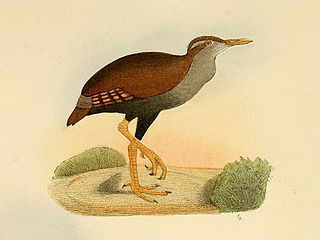 W
WThe bar-winged rail was a species of bird in the family Rallidae. It was endemic to Fiji and was last collected ca 1890 in Viti Levu. The species was identified from twelve 19th century specimens, some of which are known to be in Boston, London and New York. The last unconfirmed sighting of this bird was in 1973.
 W
WThe black-throated shrikebill or black-faced shrikebill is a songbird species in the family Monarchidae.
 W
WThe red-vented bulbul is a member of the bulbul family of passerines. It is a resident breeder across the Indian subcontinent, including Sri Lanka extending east to Burma and parts of Tibet. It has been introduced in many other parts of the world and has established itself in the wild on several Pacific islands including Fiji, Samoa, Tonga and Hawaii. It has also established itself in parts of the United Arab Emirates, Bahrain, the United States and Argentina. It is included in the list of the world's 100 worst invasive alien species.
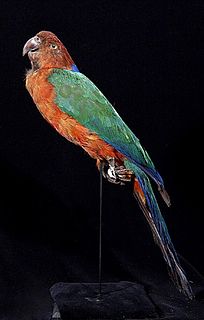 W
WThe crimson shining parrot is a parrot from Fiji. The species is endemic to the islands of Kadavu and Ono in the Kadavu Group. The species was once considered conspecific with the red shining parrot of Vanua Levu and Taveuni, but is now considered its own species. The species is sometimes known as the Kadavu musk parrot.
 W
WThe crimson-crowned fruit dove is a species of bird in the family Columbidae. It is found in American Samoa, Fiji, Marshall Islands, Niue, Samoa, Tonga, and Wallis and Futuna Islands. Its natural habitats are subtropical or tropical moist lowland forest and subtropical or tropical mangrove forest.
 W
WThe many-colored fruit dove is a species of bird in the family Columbidae. It occurs on islands in the south-west Pacific Ocean where it is found in Fiji, the Samoan Islands, and Tonga. Its natural habitat is subtropical or tropical moist lowland forests. It usually feeds high in the canopy on fruit and berries, especially figs. The nest is a small platform of twigs where one white egg is laid.
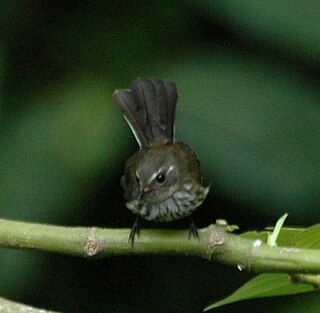 W
WThe streaked fantail is a species of bird in the family Rhipiduridae. Rhipidura verreauxi has precedence over Rhipidura spilodera. It is found in Fiji, New Caledonia, and Vanuatu. Its natural habitats are subtropical or tropical moist lowland forests and subtropical or tropical moist montane forests.
 W
WThe Fiji bush warbler is a species of bird in the family Cettiidae. It is endemic to the islands of Fiji. There are four subspecies occurring on all the main islands of the group. The species has been afforded its own genus, Vitia, in the past, but similarities of egg colour, song and morphology place it firmly within the Horornis bush-warblers.
 W
WThe Fiji goshawk is a species of bird of prey in the family Accipitridae. It was once considered to be the same species (conspecific) as the brown goshawk of Australia and New Caledonia. It is endemic to Fiji, where it occurs on the larger islands of Viti Levu, Vanua Levu, Taveuni, Kadavu, Gau and Ovalau. It occupies a range of wooded habitats in Fiji, from natural rainforest to coconut plantations and urban gardens and parks.
 W
WThe Fiji parrotfinch is a species of estrildid finch endemic to Fiji that was formerly considered to be a subspecies of the red-headed parrotfinch. This parrotfinch is a small, mainly green bird with a red head and tail and a stubby dark grey bill. It is found in both forested and open habitats, and has adapted well to man-made environments such as grasslands, pasture and gardens. Pairs have a courtship display in which they fly above the trees in an undulating flight, calling constantly. Breeding birds build a domed grass nest with a side entrance, and lay a clutch normally of four white eggs. Newly hatched chicks are naked and pink, with blue balls at the upper and lower corners of the gape, and black markings inside the mouth; older fledglings resemble the adults, but lack the red head colouring. The Fiji parrotfinch eats seeds, especially of grasses, and also readily feeds on insects and nectar. It forms small flocks of up to six birds after the breeding season.
 W
WThe Fiji shrikebill is a songbird species in the family Monarchidae. It is found in American Samoa, Fiji, and Tonga. Its natural habitat is subtropical or tropical moist lowland forests.
 W
WThe Fiji woodswallow is a species of woodswallow in the family Artamidae. It is endemic to most of the islands of Fiji, although it is absent from Kadavu Archipelago and the Lau Archipelago. The species was once considered a race of the white-breasted woodswallow, which breeds from Australia, New Caledonia and Vanuatu through to Borneo and the Philippines. Some authors retain it in that species.
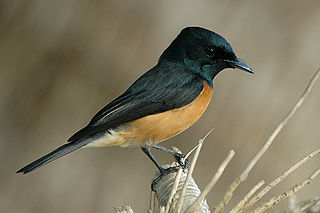 W
WThe Vanikoro flycatcher is a species of monarch flycatcher in the family Monarchidae. It has a slightly disjunct distribution, occurring on Vanikoro island and in Fiji.
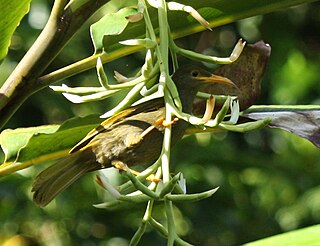 W
WThe giant honeyeater or duetting giant honeyeater is a species of bird in the family Meliphagidae. It is endemic to Fiji.
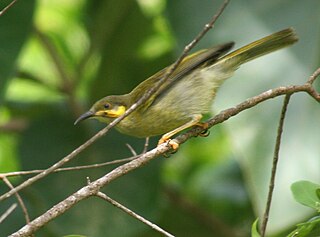 W
WThe Polynesian wattled honeyeater or the eastern wattled honeyeater, is a species of bird in the honeyeater family Meliphagidae. It was considered conspecific with the Fiji wattled honeyeater and the kikau.
 W
WThe Kadavu fantail is a species of bird in the fantail family Rhipiduridae. It is endemic to Kadavu and Ono in the Kadavu archipelago, in southern Fiji. It is closely related to the streaked fantail of the rest of Fiji, and forms a superspecies with the numerous island species of fantail ranging from the Solomon Islands to Samoa.
 W
WThe Kadavu honeyeater is a species of bird in the family Meliphagidae. It is the only species placed in the genus Meliphacator. It is endemic to the islands of Kadavu in Fiji. Its natural habitats are subtropical or tropical moist lowland forests and tropical mangrove forests.
 W
WThe kikau or western wattled honeyeater is a species of bird in the honeyeater family Meliphagidae. It was considered conspecific with the Fiji wattled honeyeater and the Polynesian wattled honeyeater.
 W
WThe red-throated lorikeet is a critically endangered lorikeet endemic to Fiji. It is 18 cm long and is bright green overall, with red cheeks, throat and thighs.
 W
WThe collared lory is a species of parrot in the family Psittaculidae, and it is the only species in the genus Phigys. It is endemic to the islands of Fiji. It is the only Fijian rainforest bird to adapt to urban landscapes and can be found in urban Suva. Measuring 20 cm (7.9 in), it has bright red underparts and face with a purple crown and greenish upperparts. Males and females are similar in plumage, although the latter have a paler crown.
 W
WThe maroon shining parrot or red shining-parrot, Prosopeia tabuensis, is a species of parrot in the family Psittaculidae. It is endemic to the islands of Vanua Levu and Taveuni in Fiji and was introduced to the islands of southern Tonga in prehistoric times. The species is sometimes considered conspecific with the crimson shining-parrot of Kadavu. Its natural habitats are subtropical or tropical moist lowland forests and subtropical or tropical mangrove forests.
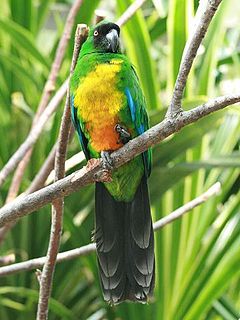 W
WThe masked shining parrot, also known as the masked parrot, masked musk parrot, or the yellow-breasted musk parrot is a species of parrot in the family Psittaculidae. It is endemic to Viti Levu in Fiji. Its natural habitats are subtropical or tropical moist lowland forest, subtropical or tropical mangrove forest, subtropical or tropical moist montane forest, arable land, and rural gardens. It is threatened by habitat loss.
 W
WThe orange fruit dove, also known as flame dove, is a small, approximately 20 cm (8 in) long, short-tailed fruit-dove in the family Columbidae. One of the most colorful doves, the male has a golden olive head and elongated bright orange "hair-like" body feathers. The golden-olive remiges are typically covered by the long orange wing coverts when perched. The legs, bill and orbital skin are bluish-green and the iris is whitish. The female is a dark green bird with blackish tail and orange-yellow undertail coverts. The young resembles females.
 W
WThe oceanic eclectus parrot is an extinct parrot species which occurred on Tonga, Vanuatu and possibly on Fiji. Its only living relative is the eclectus parrot, which has proportionally larger wings than the oceanic eclectus parrot. The fossil material unearthed in November 1989 in Late Pleistocene and Holocene deposits on 'Eua, Lifuka, 'Uiha and Vanuatu and described in 2006 by David William Steadman include a complete femur, five radii, a quadrate bone, a mandible, a coracoid, two sterna, two humeri, two ulnae, two tibiotarsi, a carpometacarpus, a tarsometatarsus, and three pedal phalanges.
 W
WThe collared petrel is a species of seabird in the family Procellariidae. It is sometimes regarded as a subspecies of Gould's petrel.
 W
WThe pink-billed parrotfinch is a species of estrildid finch found on the island of Viti Levu, Fiji. Commonly found at undisturbed mature forest in the centre and east of Viti Levu, e.g. Joske's Thumb near Suva. This species is found at mid-height along tree-trunks and branches, usually alone or in pairs but also joining mixed-species flocks, feeding primarily on insects, but also on flower buds and fruits.
 W
WThe shining parrots, Prosopeia, are a genus of parrots.
 W
WThe slaty monarch is a species of bird in the family Monarchidae endemic to Fiji. Its natural habitat is subtropical or tropical moist lowland forests.
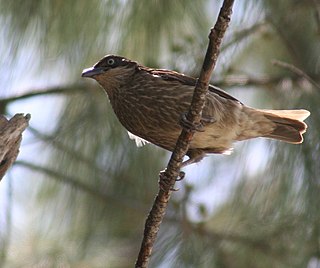 W
WThe Polynesian starling is a species of starling of the family Sturnidae. It is found in the Samoan Islands, Fiji, Niue, Tonga, the Santa Cruz Islands and Wallis and Futuna. Its natural habitats are subtropical or tropical dry forests and tropical moist forests. Various subspecies exist throughout this wide range, some darker in coloration and some lighter. Its call is a raspy buzz or rattle. Diet is fruit and insects.
 W
WThe sulphur-breasted myzomela, also known as the orange-breasted myzomela or orange-breasted honeyeater, is a species of bird in the family Meliphagidae.
 W
WThe Taveuni silktail is a species of bird endemic to Fiji. This beautiful bird looks superficially like a diminutive bird-of-paradise but it is actually closely related to the fantails.
 W
WThe Polynesian triller is a passerine bird belonging to the triller genus Lalage in the cuckoo-shrike family Campephagidae. It has numerous subspecies distributed across the islands of the south-west Pacific.
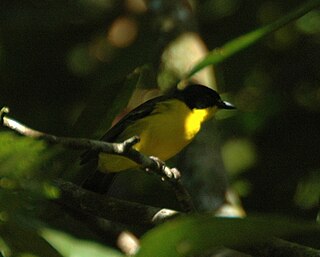 W
WThe Fiji whistler is a species of bird in the family Pachycephalidae, endemic to Fiji.
 W
WThe whistling fruit dove, also known as the velvet dove or yellow-headed dove, is a small fruit dove from Fiji. The species is endemic to the islands of Kadavu and Ono in the Kadavu Group in the south of Fiji.
 W
WThe Fiji white-eye is a species of passerine bird in the white-eye family Zosteropidae. The species is also known as Layard's white-eye. It is endemic to the islands of Viti Levu, Vanua Levu, Taveuni, Kadavu, and Ovalau in Fiji, where it is a common bird of forests. Where it co-occurs with the closely related silvereye it is more common in denser forest.
 W
WThe white-rumped swiftlet is a species of swift in the family Apodidae.
 W
WThe yellow-billed honeyeater, yodeling giant honeyeater, or chattering giant honeyeater is a species of bird in the family Meliphagidae. It is endemic to Fiji.